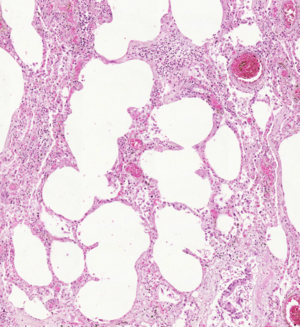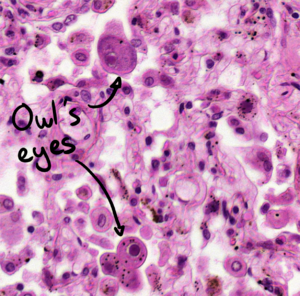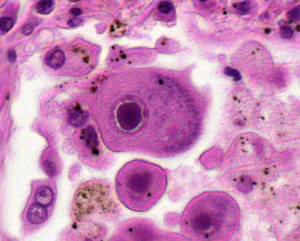46. CMV lung: Difference between revisions
(Created page with "'''Staining''': HE '''Organ''': Lung '''Description''': Only a small region in the upper left corner shows healthy lung parenchyme. The rest of the slide shows inflammation of the lung interstitium, the alveolar septa. The interstitium is so thickened that the majority of the slide is interstitium, not alveolar spaces. The alveolar spaces are empty. A special cell morphology called “Owl’s eye” can be seen. These cells are enlarged and have inclusion bodies ins...") |
No edit summary |
||
| Line 1: | Line 1: | ||
'''Staining''': HE | [[File:CMV lung overview.png|thumb|Overview of the slide|300x300px]]'''Staining''': HE | ||
'''Organ''': Lung | '''Organ''': Lung | ||
| Line 11: | Line 11: | ||
A special cell morphology called “Owl’s eye” can be seen. These cells are enlarged and have inclusion bodies inside the nucleus. | A special cell morphology called “Owl’s eye” can be seen. These cells are enlarged and have inclusion bodies inside the nucleus. | ||
'''Diagnosis''': Cytomegalovirus pneumonitis | '''Diagnosis''': Cytomegalovirus pneumonitis[[File:CMV lung comparison.png|thumb|Compare the alveoli of the unaffected part of the lung (top) and the affected part (bottom). The alveoli in the unaffected lung have their characteristic wiggly shapes. The alveoli in the inflamed interstitium are round, because the interstitium has been enlarged, which has stretched the alveolar septa.|417x417px]]'''Causes''': | ||
'''Causes''': | |||
* Immunosuppression | * Immunosuppression | ||
| Line 22: | Line 20: | ||
Cells infected by the virus become very large, and accumulate inclusion bodies, which are aggregates of protein that are visible macroscopically. | Cells infected by the virus become very large, and accumulate inclusion bodies, which are aggregates of protein that are visible macroscopically. | ||
[[File:CMV lung alveoli.png|thumb|Yes, these are alveoli|left]] | |||
[[File:CMV lung owl cells.png|thumb|Owl’s eye morphology. Note the large size and the white “halo” around the nucleolus.|left]] | |||
[[File:CMV lung alveoli.png | [[File:CMV lung owl cells 2.png|thumb|Another one. Note the inclusion bodies inside the cytoplasm]] | ||
[[File:CMV lung owl cells.png | |||
[[File:CMV lung owl cells 2.png | |||
[[Category:Pathology 1 - Histopathology slides]] | [[Category:Pathology 1 - Histopathology slides]] | ||
Revision as of 12:40, 5 July 2024
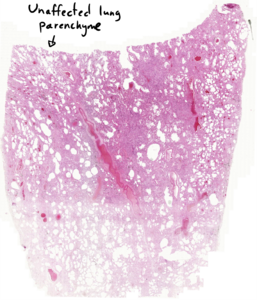
Staining: HE
Organ: Lung
Description:
Only a small region in the upper left corner shows healthy lung parenchyme. The rest of the slide shows inflammation of the lung interstitium, the alveolar septa. The interstitium is so thickened that the majority of the slide is interstitium, not alveolar spaces.
The alveolar spaces are empty.
A special cell morphology called “Owl’s eye” can be seen. These cells are enlarged and have inclusion bodies inside the nucleus.
Diagnosis: Cytomegalovirus pneumonitis
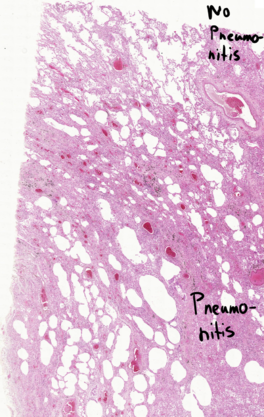
Causes:
- Immunosuppression
Theory:
Cytomegalovirus doesn’t cause pneumonia, it causes pneumonitis, because it’s the interstitium that’s inflamed and not the alveolar space.
Cells infected by the virus become very large, and accumulate inclusion bodies, which are aggregates of protein that are visible macroscopically.
